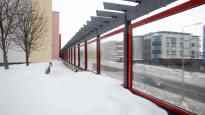A large flock of tiles flew to the glass fence of the apartment building in Kuopio. Thirty birds survived and are still in care. The housing association is now considering removing rowans from the yard.
A fatal glass fence collided with a swarm of tilipes eating in the rowan. Photo: Timo Turpeinen
The feathers stuck to the surface of the glass fence are reminiscent of an accident in Itkonniemi, Kuopio, more than a week ago.
There had been a large flock of terns growing in the yard growing in the yard of the apartment building, the majority of which died when the birds flew straight towards the glass fence lining the yard.
Savon Animal Welfare Volunteer Adviser alerted to the scene Minna Pellinen describes the view in the yard as shocking.
– There were a hundred meters of birds. Some of the magpies had already had time to strike.
Pellinen calculates that he has collected more than sixty dead birds. He believes there will be more dead birds inside the hangen, as it was snowing heavily at the time.
– The sight was pretty awful.
Minna Pellinen collected the dead birds from the yard and took the survivors for treatment. Photo: Timo Turpeinen
Rowan cut or fence grille?
The glass fence bordering the apartment building is one hundred meters long. Chairman of the Board of the Housing Company Raimo Tuomainen according to the fence has been flown by birds sometimes in the past, but not in such quantities.
– They’ve been isolated cases, a few birds.
The architect who had once designed the fence could not have imagined the massacre of birds. Executive Vice President of QVIM Arkkitehdit Oy Rainer Qvick does not remember the same thing that happened throughout his career, that is, for almost forty years.
– This is the first time on such a scale. And also, so to speak, a stopping time.
The glass fence is one hundred meters long. Photo: Timo Turpeinen
According to Raimo Tuomainen, the housing company is now considering what could be done about it.
– The first thing to do would be to knock down those rowans. Maybe you could also put a grille or darkening on the glazing, Tuomainen ponders.
He believes the housing association will decide the matter quickly. Before that, however, Tuomainen intends to contact the neighboring housing company.
– There’s a similar glass fence.
According to Raimo Tuomainen, the housing association may knock down the rowans in the yard so that they do not act as a lure for birds. Photo: Timo Turpeinen
“Almost four pounds a day”
The tils that survived the collision are still in the care of Minna Pellinen. The recovery space is the end of the outbuilding, which is surrounded by a net.
Pellinen has provided blueberries, blackcurrants and lingonberries with food for the birds.
– They eat almost four pounds a day, Pellinen sighs.
Some of the birds that collided with the fence are already ready for release. Photo: Timo Turpeinen
Pellinen pays for most of the berries from his own bag. He deplores the warfare of the fence.
– This isn’t a cool hassle. The structures of the shelter will be new in the summer, he smiles.
Some of the birds in the enclosure are already starting to be ringed and released, but not all.
– Everyone is an individual. Everyone has received an individual collision injury and shock.
The birds being treated eat nearly four pounds of berries a day. Photo: Timo Turpeinen
One option is a hawk sticker
The Kuopio fence is one example of glass construction that has become increasingly common. Terraces and balconies are glazed, and bus shelters, for example, are often made of glass.
According to Minna Pellinen, it is also common for birds to fly towards the glass. Many of the birds that come to him for treatment have some degree of collision injury.
Pellinen points out that collisions can be prevented in quite simple ways. One of them is a hawk sticker to be attached to the glass.
– It is a very affordable solution that helps in many cases. In the residential building, on the other hand, curtains help.
A fence and a rowan that can act as a lure for birds. Photo: Timo Turpeinen
And would it be possible to take the risk of collision associated with glass construction into account at the design table? The architect’s answer is yes.
– One can think about how the forest is reflected in the windows, for example.
He also believes that birds should not be attracted, for example, by plantations with berries. On the other hand, various deterrents and repellents are also available.
Rainer Qvick assures that the mass death of a swarm of tilip has corroded at least his brain cells.
– Of course, things are examined and considered twice and even three times.
